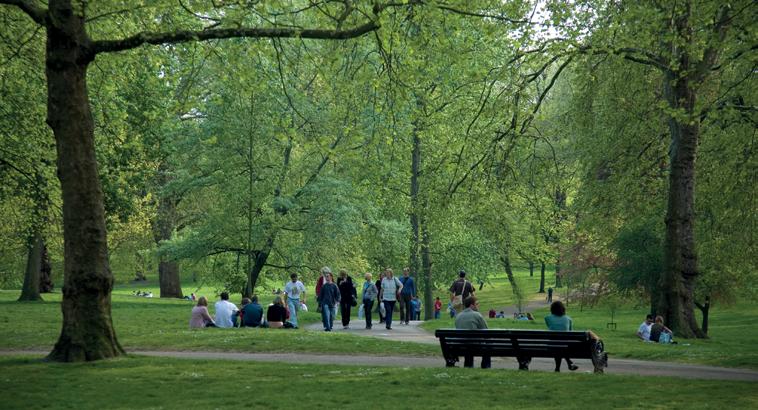Urban Planning, Environment and Health Initiative

Urban Planning, Environment and Health Initiative
The Urban Planning, Environment and Health Initiative uses scientific evidence to promote healthy and sustainable cities
The connection between the health of the population and the environment must be the foundation for the urban planning. Prosperous cities are those designed to be healthy, sustainable and livable. Today, more than half of the world’s population lives in urban areas, and this proportion is expected to increase to between 70% and 80% over the next 20 years.
Air pollution kills 4 million people a year
Cities are centres of innovation and wealth creation, but they are also main sources of pollution and disease. A growing body of research links poor urban and transport planning to harmful environmental exposures, low levels of physical activity, and ill health. Increasing urbanization has been accompanied by a rapid increase in non-communicable diseases (NCDs), accounting for the largest burden of disease worldwide. NCDs cause 68% of global mortality, and will cost a projected $30 trillion between 2011 and 2030.
The World Health Organisation (WHO) estimates that air pollution alone is
responsible for four million deaths a year. Ambient air pollution negatively affects health in many ways, contributing to cardiovascular, cerebrovascular and respiratory disease. It is a leading cause of death from heart diseases (27%), lung cancers (36%), chronic obstructive pulmonary disease (COPD) (35%) and strokes (34%).
Cities could prevent 20% of premature deaths with better urban and transport planning
Physical inactivity is considered to be one of the most significant health problems of this century, and is estimated to cause some 2.1 million deaths every year worldwide.
Noise pollution has been associated with numerous negative effects, including impaired cognitive function, sleep disturbance, cardiovascular disease, obesity and type 2 diabetes.
Heat islands, the result of the concrete and asphalt urban environments in cities, also increase illness and death.
In addition, inequities are often exacerbated in urban settings, and further contributing to poor health outcomes and leading to a cycle of entrenched poverty.
Within the challenges posed by urbanisation there are also significant opportunities for intervention. Strategies designed to increase access to blue and green spaces have been shown to have a positive impact on health by contributing to reductions in stress, mental health problems and cardiovascular disease.
Active transport – walking and cycling- is an effective and efficient way to make physical activity an integral part of daily life in urban areas, as well as to reduce cars in cities.
Multi-sectoral and systemic approaches are needed to address these complex planning, environmental and health problems, and novel, comprehensive strategies are needed to protect and promote health and well-being.
How Urban Environment Impacts our Health
Evidence plays a vital role in the process of rethinking our cities, informing urban design and planning decisions and providing the data needed to evaluate interventions. For example, an ISGlobal’s research estimates that premature mortality could be reduced by 20% a year if cities complied with international recommendations on physical activity, access to green space and exposure to air pollution, noise and heat.
Head stroke, cerebrovascular diseases
mental health
neurodegenerative diseases
autism, child behaviour problems
cognitive impairment
Heart
myocardial infarction
Respiratory tract
lung cancer
asthma
respiratory diseases
Breast
breast cancer
Reproductive system and fetus
low birth weight
preterm birth
lower sperm quality
Digestive system
colon cancer
arrhythmia
cardiovascular diseases
Arteries
hypertension
General sleep disturbance
and annoyance
labour and traffic incidents with injury
obesity
diabetes
thrombosis
systemic inflammation
increase in mortality
Health conditions associated with air pollution noise temperature and a lack of physical activity naturals spaces
Source: WHO; Natalie Mueller, 2017 ; 107:243-257.
oi:10.1016/j.envint.2017.07.020.
Research
The Initiative’s research agenda focuses on the relationship between population health, urban and transport planning and environmental exposures. Topics include air quality, noise pollution, heat effects, interactions with green and blue spaces as well as lifestyle factors, such as active transport and physical activity levels. Our aim is to gain a better understanding of how and when environmental exposures influence health or well-being and the contribution of different exposures to disease.
Our research uses a combination of innovative tools to gather exposure data. These include geographic information systems (GIS), satellite data, personal monitoring systems and smartphones. The use of methodologies like Health Impact Assessment (HIA) and citizen science help ensure that our work is closely linked to the needs and priorities of policy makers and other stakeholders.

Scientific objectives:
· To generate knowledge about environmental exposures and their mechanisms, particularly in urban contexts where little research has been conducted.

· To develop new epidemiological and statistical methodologies and novel techniques for assessing exposures, applied to air pollution, green/blue space, temperature, noise, and active transportation research in urban contexts.
· To increase the use of tools and participatory methods, such as Health Impact Assessment and citizen science, in the research and design of strategic interventions.
· To promote healthy urban living by providing scientific evidence on exposures to and the effects of air pollution, green/ blue space, temperature, noise, and physical activity.
Policy and Global Development
To deal with the challenges posed by unprecedented urbanisation we need to adopt a global perspective, identify local and regional mechanisms for action, and pay close attention to inequities in the distribution of both risks and benefits. ISGlobal works closely with actors worldwide to ensure that evidence is translated to policy and decision-making. The aims of the Initiative are aligned with the Sustainable Development Goals (SDGs) and the New Urban Agenda.
In Barcelona, ISGlobal is collaborating with local and regional governments to highlight the links between urban environments and health and to incorporate health evidence into urban planning. ISGlobal also serves on several committees acting as technical advisors.
In Spain, the institute is a member of REDS, the Spanish Network for Sustainable Development, and has participated in a number of events
related to the local implementation of the New Urban Agenda.
Throughout Europe, ISGlobal is working with institutions and universities in many countries to generate new scientific evidence. It also collaborates with the WHO on drafting guidelines and tools related to air pollution, noise, green space and active transportation.
On the international level, the institute collaborates with multilateral agencies, such as the WHO and UN-Habitat, providing technical expertise and input into Physical Activity, Noise, Air Pollution and Green Spaces guidelines and the New Urban Agenda. In addition, ISGlobal works to bring the health perspective to urban networks, advocacy organisations and international cooperation agencies. The institute also participates in the Global Health and Planetary Health platforms and efforts to highlight the contribution of urban health to the sustainable development agenda.

Training and Education
In terms of education, Initiative aims to build capacity through training programmes for current practitioners and future leaders. A key outcome is the creation of communities of practice bringing together urban and transport planners, health professionals, economists and environmental specialists and developing a shared language and cross-sector tools.
Training of doctoral and master students
Short courses for university students:
· MSc Global Health: Environmental Health & Health Impact Assessment
· Master in Public Health –Risk Assessment & Exposure Assessment
· Environmental Health for Medical Students
Courses for local government policy-makers and technical staff:
· Health Impact Assessment
· Environmental Epidemiology
· Environmental Exposures and Health
· Car-free City Planning

· Greening of Cities
· Strategies for Active Transport
ISGlobal works to translate scientific evidence to decision-making
5 Key Ways to Create Healthy Urban Environments

1. Air Pollution: Reducing motorised vehicles
2. Physical Activity: Increasing active transport
3. Noise: Reducing motorised vehicles
4. Green and Blue Spaces: Increasing the availability of and access to nature
5. Temperature: Reducing infrastructure for motorised vehicles and increasing green spaces
www.isglobal.org
@ISGLOBALorg
ISGlobal’s mission is to promote health equity through excellence in research and the translation and application of knowledge. Our vision is a world in which all people can enjoy good health.
ISGlobal Initiatives
· Antibiotic Resistance Initiative
· Chagas Initiative
· Malaria Elimination Initiative
· Maternal, Child and Reproductive Health Initiative
· Urban Planning, Environment and Health Initiative
A partnership of:
Facebook.com/isglobal @ISGLOBALorg






